All about growing abelia
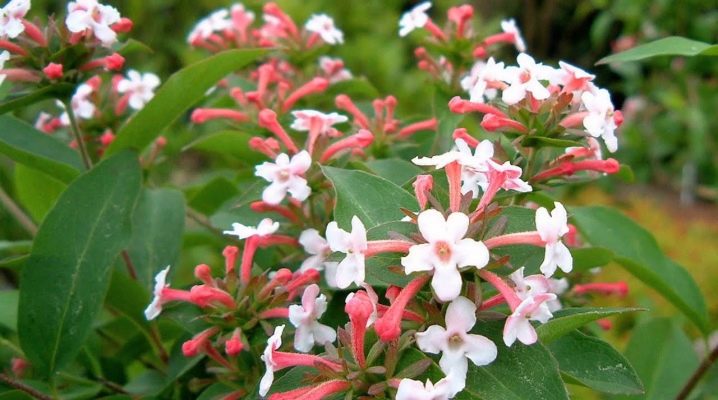
A blooming garden, delighting with bright colors and fragrance during almost the entire summer season, is the dream of any owner of a personal plot. This dream can be realized quite easily - you just have to land the beautiful Abelia on the territory. This spectacular perennial is highly prized by gardeners and landscape designers for its unsurpassed decorative effect, as well as for its abundant and long flowering.
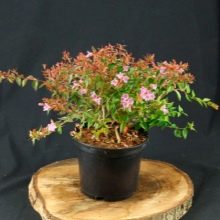
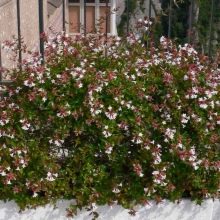
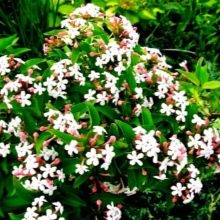
Description
The genus Abelia is a member of the honeysuckle family and has about 30 (according to other sources, 35) varieties of slow-growing compact shrubs that grow in the wild in East and Southeast Asia, Mexico and southern North America. On the territory of Russia, the plant is found in the south of the Primorsky Territory.
Depending on the species and varietal characteristics, the height of the abelia can vary from 0.5 to 2.5 m. The dimensions of individual vigorous representatives of the genus can reach 5-6 meters.
Representatives of the Abelia genus are flowering shrubs with a lush, well-branched and spreading crown. The diameter of the crown in most species varies from 1 to 2.5 m. The branches of the shrub are flexible, thin, directed upward (in tall shrubs, they are directed downward). The leaves are usually glossy, dark or light green, pointed or ovoid, with small jagged edges. Both evergreen and deciduous forms are found in the genus. And also there are representatives of variegated (variegated) forms.
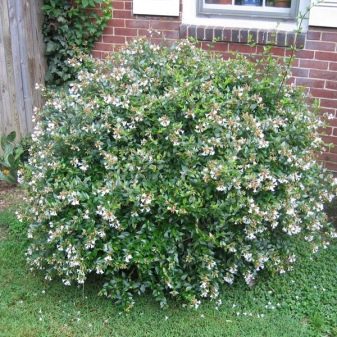
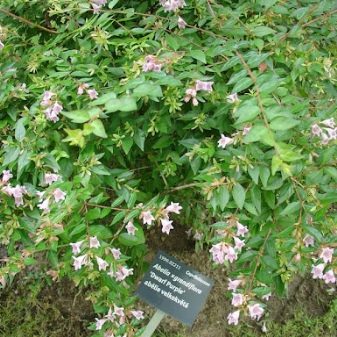
Abelia blooms in early June, blooms in September-October. During the flowering period, the crown of the shrub is decorated with numerous funnel-shaped or tubular flowers with a strong and very pleasant, delicate aroma.
The color of the flowers depends on the species (varietal) characteristics of the plant. The color palette ranges from white, creamy pink and rose red to pale lilac and pale purple. Some varieties of abelia retain their decorative effect after flowering due to the red and red-brown sepals remaining on their branches.
Among gardeners, the described shrub is valued not only for its impressive decorative effect, but also for its relative unpretentiousness.
Some members of the Abelia genus, despite their exotic origin, are able to easily endure temperature drops and significant cold snaps.
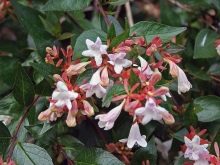
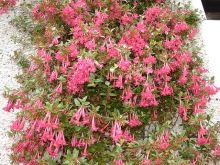
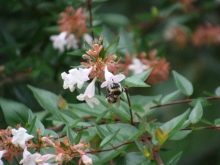
Types and varieties
In addition to wild and cultivated species of abelia, there are also hybrids bred by breeders. Below are the names of the most popular varieties of decorative abelia that are popular among gardeners and landscape designers.
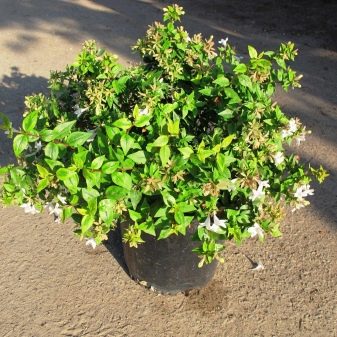
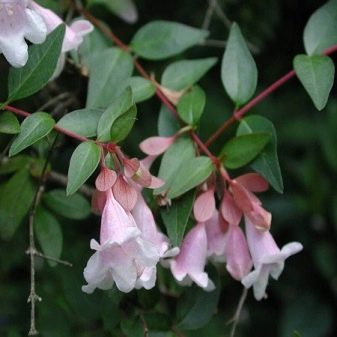
Large-flowered
Large-flowered, or Abelia grandiflora, is a hybrid variety of Abelia obtained by crossing the species Abelia chinensis and Abelia uniflora. An adult plant is a well-branched, strong bush up to 2 meters high. The leaves are elliptical, emerald green, with a glossy outer surface. The flowers are bell-shaped, five-petal, white with a pink tinge, collected in neat small panicles.

One of the relatively new varieties of large-flowered abelia is Kaleidoscope. Abelia "Kaleidoscope" - variegated (variegated), is a low, lush shrub with graceful, upward shoots. The color of the leaves of the plant changes over time from pale green to golden yellow and purple.The flowers are large, funnel-shaped, white or cream-white.
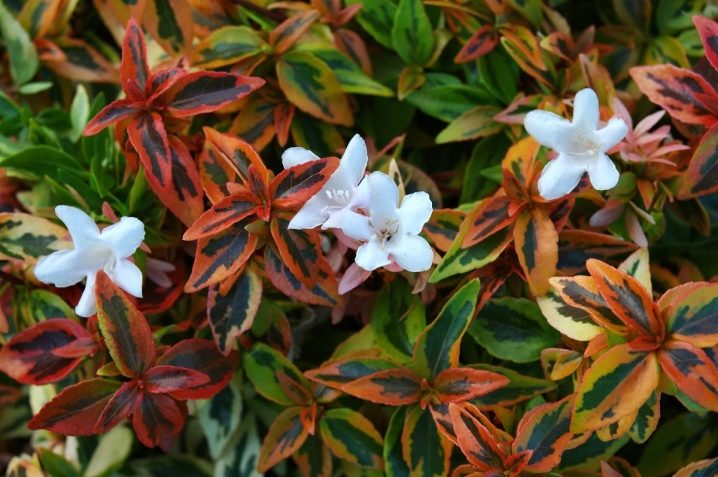
Korean
A species found on the territory of Russia in the Primorsky Territory. An adult shrub reaches a height of 1.7-2 m, is distinguished by a splendor and spreading crown. The diameter of the bush can also be 1.5-2 meters or more. The leaves are pointed-oval in shape, with small serrations along the edges, dark green in color. The branches are thin, directed upwards. The flowers are white-pink, small, united in loose panicles.
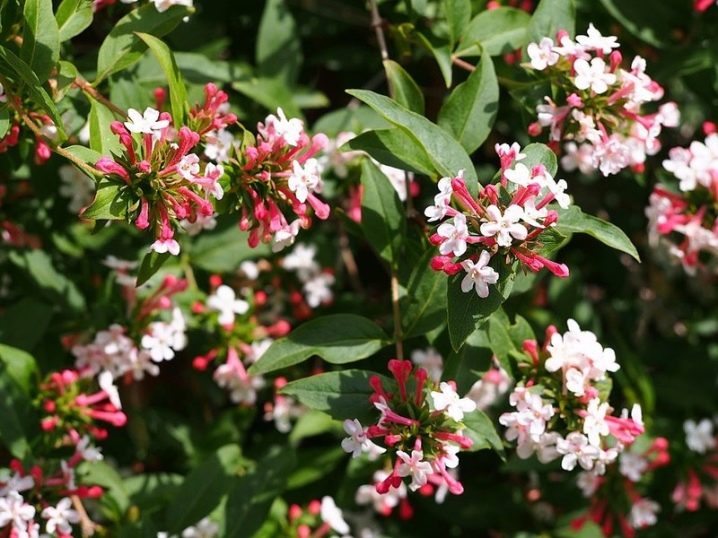
Chinese
This species is ubiquitous in Taiwan, Japan and China. It is a compact deciduous shrub with a powerful, branched crown. Branches are thin, flexible, covered with reddish-brown bark. The flowers are small, white, funnel-shaped.
It is noteworthy that the foliage of the Abelia of this species, at the end of the growing season, changes from its original green color to purple-red (the species is represented by deciduous forms).
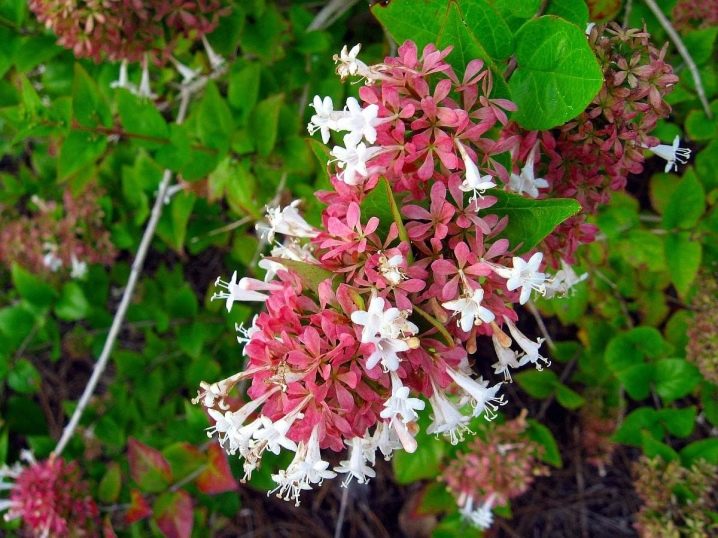
Schumann
A deciduous variety of Abelia that blooms most of the summer. With good care, the height of the bush can reach 2 meters or more. It does not tolerate sudden temperature changes and prolonged cold snaps, therefore the plant is recommended for growing at home - greenhouses and heated greenhouses. The flowering is profuse and long lasting. The flowers are small, numerous, pinkish lilac or pale lilac in color.
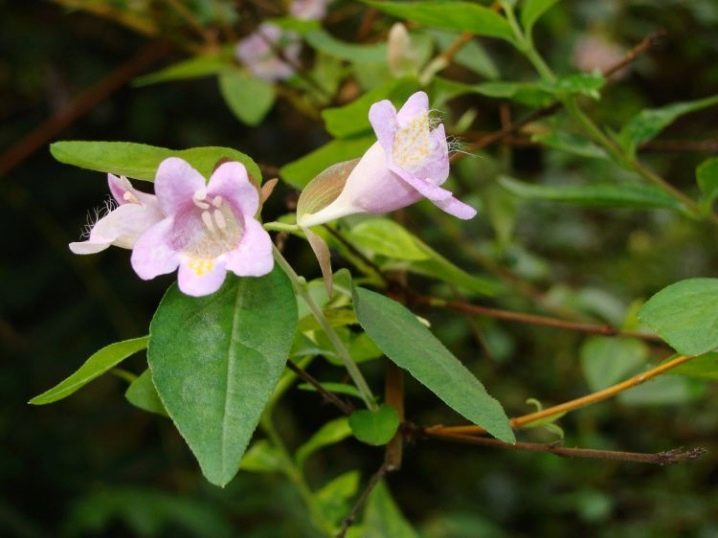
Blooming profusely
A spectacular variety of evergreen abelia with a graceful, very spreading crown. Branches are thin, downward, pale reddish or light reddish brown. Leaves are glossy, lanceolate, pointed, rich green color. The flowering of this species of Abelia begins in May and lasts almost until mid-autumn. During this period, the plant is covered with a large number of fragrant pale pink or dark pink funnel-shaped flowers.

Mosanskaya
Cold hardy early flowering Abelia. It is a low, spreading bush with a height of about 1.5 m. The leaves are dark green, pointed, glossy. The flowers are large, funnel-shaped, white or cream-colored. The aroma of flowers is intense, with pronounced jasmine and hyacinth notes.
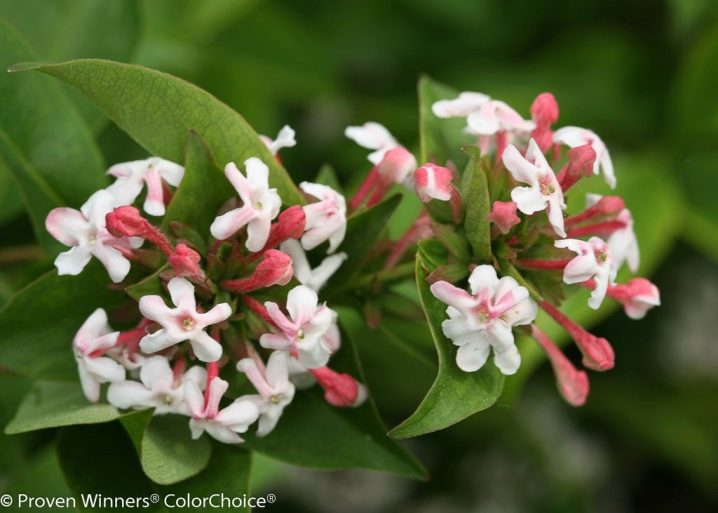
Landing
The shrub is planted in well-lit or poorly shaded areas, protected from wind and drafts. The soil at the planting site should be loose, fertile, well-drained.
The size of the planting pit should slightly exceed the diameter of the root ball of the seedling. A drainage layer (crushed stone, broken brick, expanded clay) must be laid at the bottom of the pit. When planting shrubs on a site with heavy clay soil, coarse river sand is additionally introduced into the planting pit.
The plant is planted by transshipment, along with a lump of earth on the roots. A seedling placed in a pit is carefully covered from all sides with loose garden soil mixed with humus and peat.
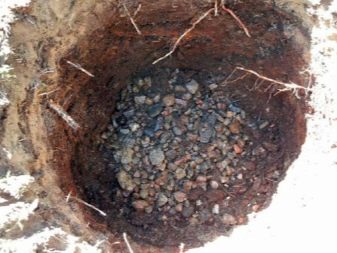
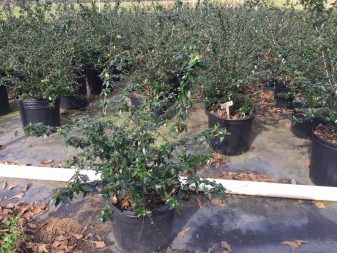
After planting, the trunk circle is mulched with sawdust or humus.
Care
The rules for caring for Abelia grown both in the open field and at home (winter gardens, indoor mini-greenhouses) are practically the same. The following are the basic treatments this plant needs.
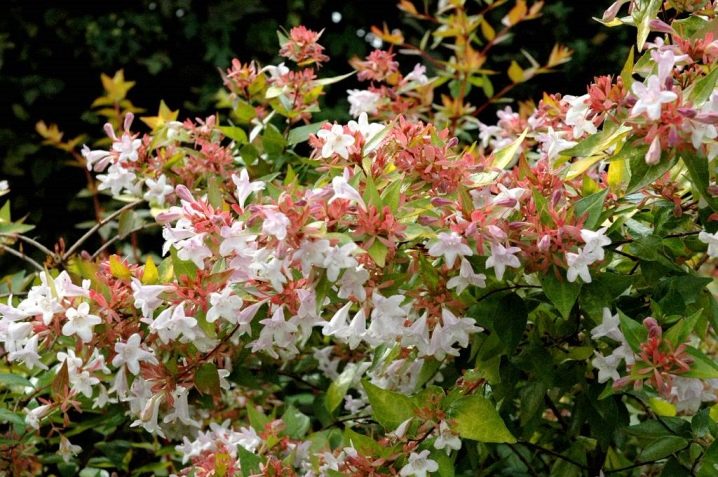
Top dressing
It is recommended to feed Abelia 2-3 times during the growing season. For top dressing, it is advisable to use complex fertilizers for ornamental shrubs - hydrangeas, rhododendrons.
At the beginning and at the end of the growing season, shrubs growing in the open field are fertilized with humus or compost, applying top dressing to the trunk circle and mixing it with the soil.
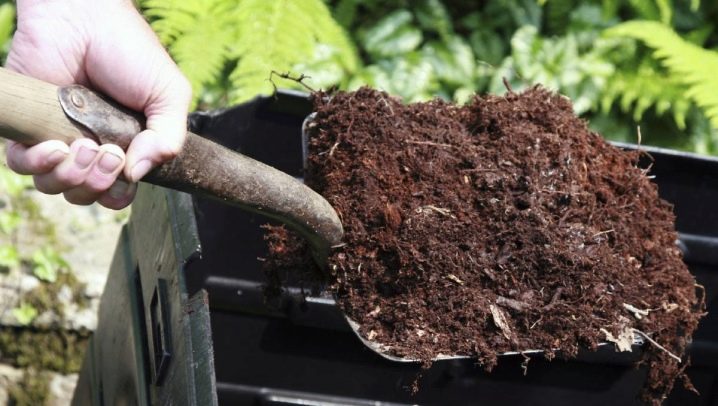
Watering
Abelia is not considered a moisture-loving plant that needs frequent watering. The only exceptions are young and flowering plants. During the period of active growth or flowering, shrubs are watered about 1-2 times a week. The same amount of watering is recommended for dry, hot seasons.In other cases, plants are watered 2-3 times a month.
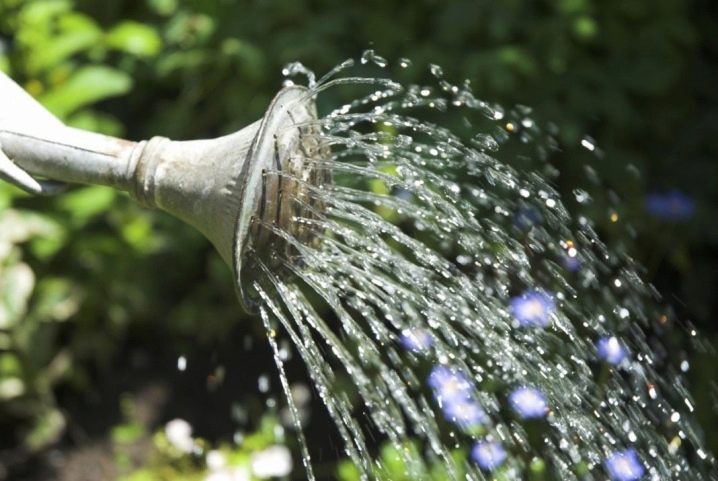
Pruning
This procedure is recommended to be carried out in February-March in relation to deciduous forms and after flowering - in relation to evergreen forms. Shrubs growing at home are recommended to be pruned at the end of winter.
During pruning, excessively elongated, as well as diseased, weak or damaged shoots are removed by a third or half of the length. In order for the plant to develop a lush crown, it is also recommended to slightly trim the tips of the shoots. This procedure will stimulate the development of adventitious (lateral) shoots, which contributes to the growth of a voluminous crown.
Old bushes growing in the open field are rejuvenated by cardinal pruning, which is carried out in the last days of February.
During the procedure, all shoots are shortened with a sterile instrument, leaving about 30-50 centimeters from each, counting from the surface of the earth.
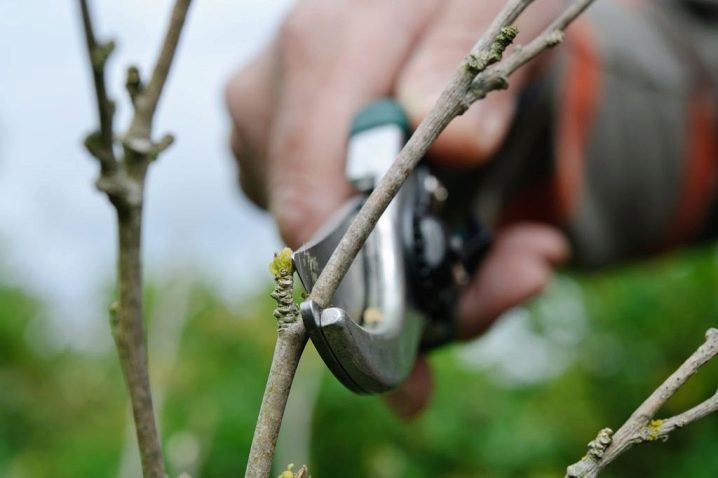
Transfer
Home-grown abelias are recommended to be replanted every 2-3 years with a complete replacement of the soil mixture. Bushes grown in the open field, without urgent need, as a rule, are not transplanted. If such a need arises, then the transplant is carried out in the same way as in the case of other ornamental plants:
- the bush is dug in around the circumference, stepping back 20-40 centimeters from the crown;
- with a sharp bayonet shovel, carefully deepen the resulting trench along its entire length.
Simultaneously with digging in the bush, they remove the roots that come across - this will allow you to extract the plant with minimal effort. Further, the bayonet of the shovel is buried under the central part of the bush and, using it as a lever, with rhythmic but careful jerks, they remove the bush from the soil.
In the future, the extracted bush is planted in a new place in the usual way.
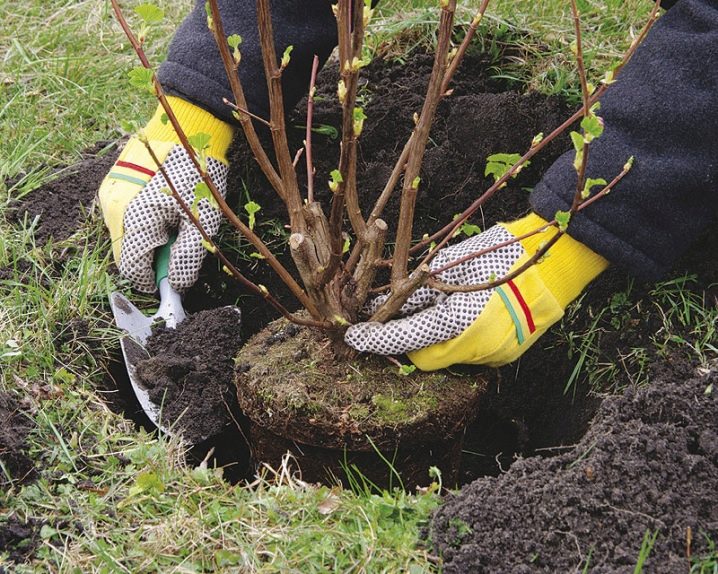
Diseases and pests
With sudden changes in air temperature, excessively abundant watering and thickening of the shoots, Abelia can become a victim of powdery mildew. This fungal disease makes itself felt by the appearance on the leaves of the plant of dirty white, and subsequently gray and brown spots. Fungicides - "Fundazol", "Vectra", "Fufanon" can effectively fight the disease. The same drugs are used for various rots that develop as a result of flooding the plant or waterlogging of the soil.
Aphids and spider mites are tiny but dangerous parasites that most commonly affect shrubs. In both cases, the affected plant begins to lag behind in development, dry out, and lose foliage. In most cases, aphids can be identified on their own - usually its colonies accumulate on the seamy side of the leaves. The invasion of a spider mite can be judged by the off-white or gray accumulations of cobwebs on the leaves and shoots of the plant. For the destruction of parasites, powerful insecticides and insectoacaricides are used - "Aktara", "Fitoverm".
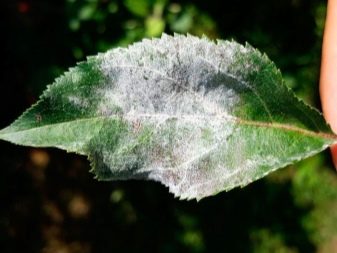
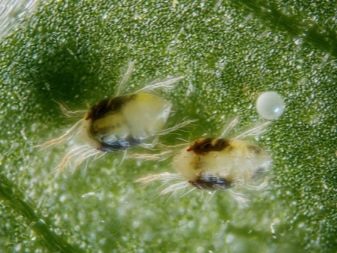
Reproduction
Optimally for the reproduction of abelia, its root shoots are suitable. To obtain a new generation of shrubs, the shoots are dug out in early spring, capturing part of the mother root, and transplanted to a permanent place. While young plants take root in a new place, they are provided with protection from the bright sun, wind and cold. You can create such protection using agrofibre.
A good result can be obtained by cuttings - a method in which abelia is propagated by semi-lignified fragments of shoots. In this case, the planting material is harvested in late summer - early autumn, when the plant has faded. Further, the rooting of cuttings is carried out in mini-greenhouses with loose fertile soil.

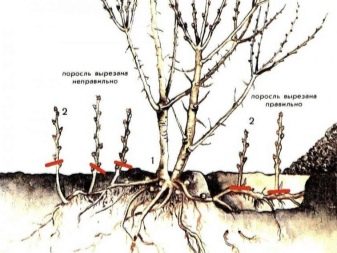
Use in landscape design
Landscapers typically use abelia to decorate recreational areas in their backyard gardens. Blooming Abelia looks perfect as a hedge, framing not only recreation areas, but also the boundaries of the site.
Using abelia as an element of a hedge, you should take into account the diameter of its crown in adulthood.
With this parameter in mind, it is necessary to plant the plant during planting at a distance of at least 2-3 meters from the adjacent green spaces.

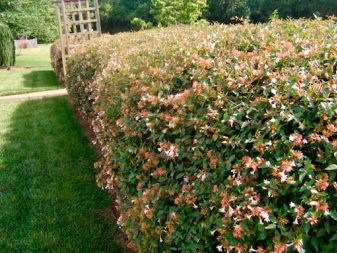
Abelia looks very impressive in a group neighborhood with other fragrant and beautifully flowering shrubs and weaving plants - hydrangea, honeysuckle, clematis. In the vicinity of it, in the foreground, smaller decorative one- and perennial flowers are usually planted - marigolds, calendula, dwarf daisies, nemophila, gypsophila, forget-me-nots.
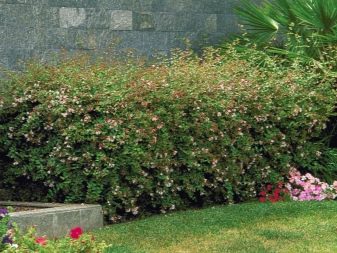
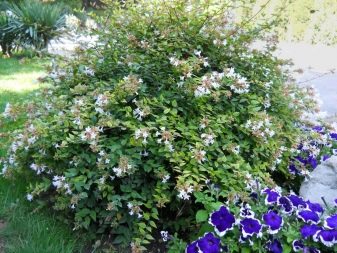













The comment was sent successfully.